Areas: Tokiwa (常盤) and Fueda (笛田)
Place Name
The term "tokiwa" (常盤 or 常葉) means "eternity" or "permanence." It also connotes that trees grow thickly and are green all year round. Since this area was and still is surrounded by green hills and is thickly forested, it came to be called Tokiwa (常葉). The characters were later changed to 常盤.| Yakumo Jinja Shrine (八雲神社) |
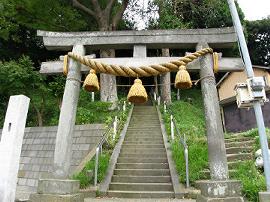
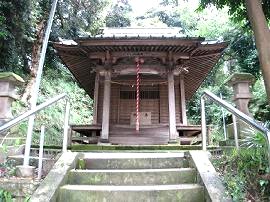
Location: Yakumo Jinja is located some 30 meters to the left from the Yakumo Jinjamae crossroads as you walk the street that leads to Kamakura City Hall and Kamakura Station. After passing through a stone torii gate built in 1862 and climbing some 50 stone steps, you will see a shrine hall.
Gropunds: The shrine is dedicated to Susaoo no Mikoto (素戔(盞)鳴命), Hayatama no O no Mikoto (速玉之男命), and Izanami no Mikoto (伊弉冉命). Its festival is held from the first Sunday of July to the following Saturday.
On the last day a mikoshi (神輿) is paraded around the area.
| Enkyuji Temple (円久寺) |
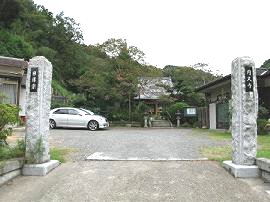
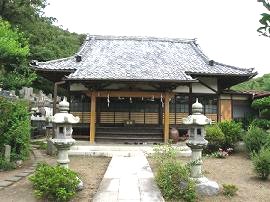
Full name: Tokiwasan (常葉山) Enkyuji
Denomination: Nichiren Zen sect (日蓮宗)
Location: Enkyuji Temple is situated to the east of Yakumo Shrine.
History: The sango was taken from the name of a villa, Tokiwa-dono (常葉殿), owned by Hojo Masamura (北条政村, 1205-1273). The origin of the temple dates back to the Heian period (794-1185/92), but it is uncertain whether the founding priest was Nissei (日惺) or Nichii (日伊), for both are mentioned.
The Main Hall houses a statue of Nichiren (日蓮, 1222-82) and a 40-centimeter-tall cabinet with the Tokugawa (徳川) family crest, which contains a wooden statue of Kishimojin (鬼子母神).
The temple is popularly called "Kosumosu-dera," or "Cosmos Temple," because the cosmos comes into full boom within the grounds in the fall.
| The Former Site of the Residence of Hojo Yoshimasa (北条義政屋敷跡) |
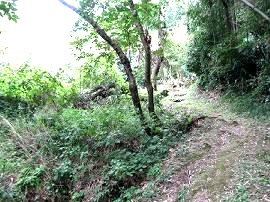
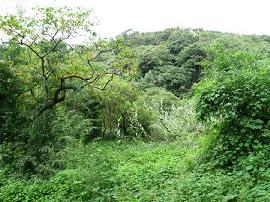
Location: If you would like to visit the former site of the Yoshimasa Residence, the way to get there is to take the lane east of Enkyuji Temple (円久寺), located some 100 meters on the right from the crossroads where the road to Kamakura Station and Kamakura City Hall (鎌倉市役所) starts. This will bring you to an open space that faces south and forms rises like terraced fields. You are now at the former site of the Hojo Yoshimasa Residence. It and the surrounding area are now designated a Historic Site by the government.
Story: Hojo Yoshimasa (北条義政, 1242-1281) was a warrior in the Kamakura period and the son of Hojo Shigetoki (北条重時, 1198-1261), himself a younger brother of Hojo Yasutoki (北条泰時, 1183-1242), the third regent. Accordingly, Yoshimasa became a prominent member of the Kamakura government and played important roles, first as hikitsukeshu (引付衆, a member of High Court), then hyojoshu (評定衆, a member of Council of State), and finally rensho (連署, a cosigner) under successive regents. The structure is thought to have been his villa because his actual residence is believed to have been located in Omachi Nagoe (大町名越).
| The Former Site of Hojo Masamura's Villa (北条政村屋敷跡) |
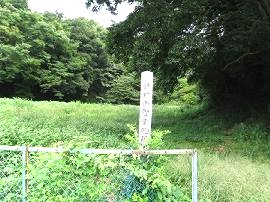
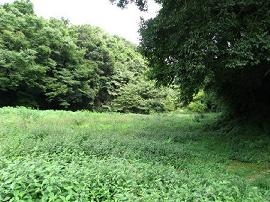
Location: After walking some 500 meters toward Kamakura Station from the former site of Hojo Yoshimasa's residence, you will see on the left a spacious ground surrounded by hills in three directions (east, west, and north) with a gentle slope south. Grass covers the ground and the area is called Tachindai (たちん台). This is where the villa of Hojo Masamura (北条政村, 1205-1273) is thought to have stood.
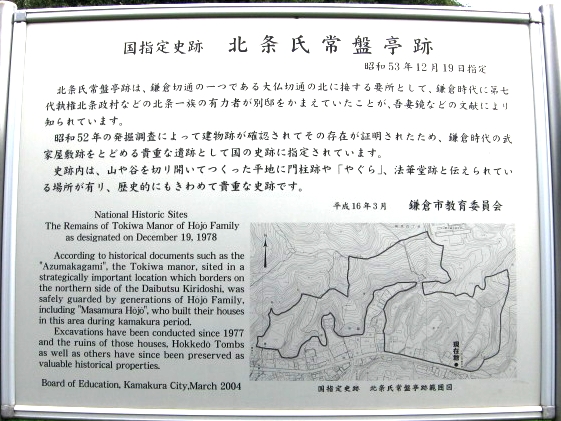
Story: Hojo Masamura was the fourth son of Hojo Yoshitoki (北条義時, 1163-1224), the second regent. He became the seventh regent after he assumed the positions of Governor of Mutsu (陸奥), and then rensho.
When he learned that the Mongol forces would invade Japan, he handed the regency over to Hojo Tokimune (北条時宗, 1251-84) and, to assist him, became rensho again. Later, he became a monk, taking the name Kakusu (覚崇), and died at the age of 69.
Masamura's actual residence was in Komachi (小町). He built his villa here and named it Tokiwagosho (常盤御所), hence he himself was also called Tokiwa-dono (常盤殿, a widely used honorific appellation). The Azuma Kagami (吾妻鏡) makes mention of the villa's magnificence, a visit by Prince Munetaka (宗尊親王, 1242-74), who was the sixth shogun, and poetry party gatherings that were held here.
The remains of paved stones, pottery, roof tiles, etc., found buried here support the accounts in the Azuma Kagami.
There is an abandoned well at the far end of the grounds, and some ten caves were discovered in the northern cliff. The biggest cave has an amusing story connected with it.
It was here in the late Edo period that a farmer supposedly found a large pot filled with cinnabar. Taking the red liquid to be blood he was so disgusted that he poured it into a nearby river. The liquid flowed as far as the Kashiogawa (柏尾川) and Katasegawa Rivers (片瀬川), changing the water to red, flabbergasting the local people and throwing them into confusion.
| Daibutsuzaka Kiridoshi Pass (大仏坂切通し) |
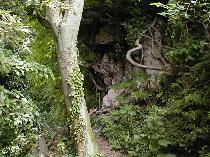
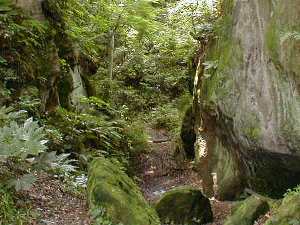
Location and Course: To visit this old pass, you will need to walk some 20 meters from Hinomishita (火の見下) Bus Stop toward Hase (長谷) and Daibutsu (大仏), then turn left into the alley that runs between private houses.
The lane soon turns into a path that leads to the hillside and will bring you to a section of steep cliffs, called Daibutsuzaka Kiridoshi Pass, which is one of the seven passes of old Kamakura. It was designated a National Historic Site in 1977.
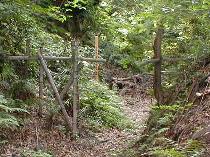
Halfway up the cliff on the left are several recesses where gorinto and other-type stupas and stone monuments once stood. By ascending the slope and continuing for a bit you will be able to see all of the Tokiwa area. The lane extends further along a residential area and continues into the hills but soon ends because a tunnel was constructed nearby.
| Butsugyoji Temple (仏行寺) |
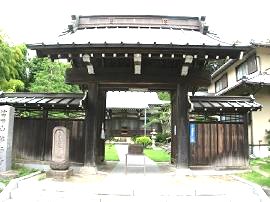
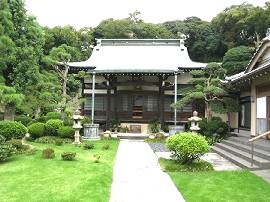
Full name: Fuedasan (笛田山) Butsugyoji
Denomination: Nichiren Zen sect (日蓮宗)
Location: The temple is set back from the main road that runs between Hase and Fujisawa, and is located close to Fueda Koen Park (笛田公園).
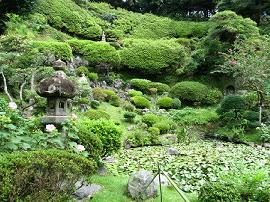
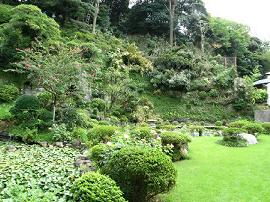
History and Grounds The founding priest was Busshoin Nisshu (仏性院日秀), who died in 1495.
The Main Hall houses a statue of Nichiren (日蓮, 1222-82). Behind the hall is a beautiful garden with a pond, well-trimmed trees, and seasonal flowers in the courtyard and on the hillside.
Areas: Kajiwara (梶原) and Terabun (寺分)
Place Name
Kajiwara got its name from the fact that Kamakura Gondayu Kagemichi (鎌倉権太夫影通), the ancestor of both Kajiwara Kagetoki (梶原景時, ?-1200) and Kagesue (景季, 1162-1200), influential but somewhat unpopular warriors in the Kamakura period, once lived here and called his family Kajiwara.The name Terabun comes from the old name of this area, Taikeiji-bun (大慶寺分), which means the territory of Taikeiji Temple.
| Togakuji Temple (等覚寺) |
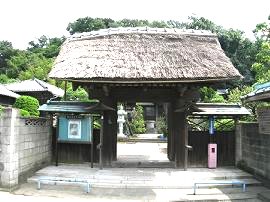
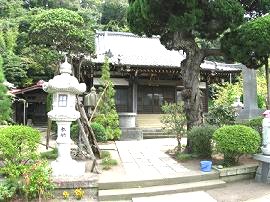
Full name: Kyujozan (休場山) Togakuji
Denomination: Shingon sect (真言宗)
Location: Togakuji is some 100 meters east from Shonan Fukasawa Station on the Shonan Monorail Line and is set back among a number of houses.
History: The temple was founded by Shukei Sozu (秀恵僧都) between 1394 and 1428.
The sango (山号) of the temple is Kyujozan (休場山), literally, "Resting-Place." The origin of the name supposedly goes back to a time when Kajiwara Kagetoki (梶原景時, ?-1200), a warrior, stopped to rest here one day as he was passing through the area.
In the Meiji period (1867-1912), a school called Kummogakusha (訓蒙学舎), the predecessor of present-day Fukasawa Elementary School (深沢小学校), was built within the grounds.
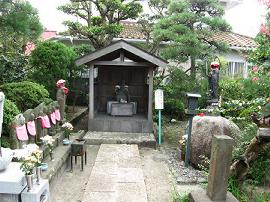
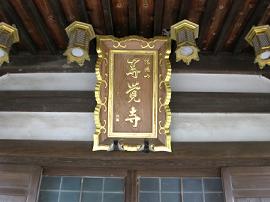
Grounds Upon passing through a yakuimon-style gate (薬医門), the Main Hall is seen ahead. To its right is Taishido Hall (大師堂), which houses a stone statue of Kobo Daishi (弘法大師, 774-835). In front of the hall are seven stone Jizo in a row.
In the Main Hall is a statue of Fudo Myoo (不動明王) in the center, and to the right a Kosodate-Shusse Jizo (子育て出生地蔵), literally, “Child-Rearing and Success-in-the-World-Helping Jizo".
| The Tomb of Kajiwara Kagetoki (梶原景時) |
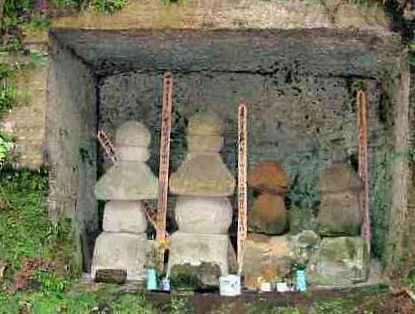
Location: The tomb is situated within the grounds of Fukasawa Elementary School, which is some 200 meters east from Shonan Fukasawa Station on the Shonan Monorail Line. To visit the tomb it is necessary to first obtain permission from the school office, then simply go around to the back of the school buildings and walk in the direction of the hillside to the east, where you will see a recess in the cliff.
Grounds: In Kamakura, this type of recess is called yagura (やぐら). The yagura here is 1.7 meters high, 2.0 meters wide and 1.5 meters deep, and contains four gorinto-type (五輪塔) stone stupas. One is said to be for Kajiwara Kagetoki and the others for various other members of the Kajiwara family, although it is now impossible to identify which is which because the surfaces of the stupas have been completely eroded.
Story of warrior Kajiwara
Kajiwara Kagetoki was once one of the most influential vassals serving under Minamoto no Yoritomo (源頼朝, 1147-99). He is also one of the least popular persons in Japanese history, because people believe Kagetoki was the cause of the discord between the two brothers, Yoritomo and Yoshitsune (源義経, 1159-89).
Although Kagetoki initially fought on the side of the Taira (平) under Oba Kagechika (大庭景親, ?-1180), he saved the life of the defeated Yoritomo at the battle of Mt. Ishibashi (石橋山) near Hakone by pretending not to see Yoritomo, who had taken shelter in a cliffside recess with some of his followers. When Kagetoki felt into the recess, he in fact discovered Yoritomo, but reported that no one could be inside because of the undisturbed cobwebs within.
Soon after the battle, he joined Yoritomo's side. Because of his talent and intelligence, he became a trusted vassal and was promoted to membership in the Samurai Dokoro (侍所, the Board of Retainers).
Kagetoki fought under Yoshitsune against the Taira, but later turned against Yoshitsune, slandering him to Yoritomo and thereby bringing about a feud between the two brothers.
When he slandered a fellow vassal, Yuki Tomomitsu (結城朝光, 1168,7-1254), he incurred the wrath of the Wada (和田), Miura (三浦) and other warriors. While fleeing from Kamakura to Kyoto in 1200, he and his relatives were found and killed in Suruga (駿河, now part of Shizuoka Prefecture).
Tombs thought to be for the Kajiwara family are located where they were killed and the tombs here are believed to have been erected later in their memory. Kagetoki himself is often portrayed in Kabuki drama and popular literature as a villain.
| Goryo Jinja Shrine (五霊神社) |
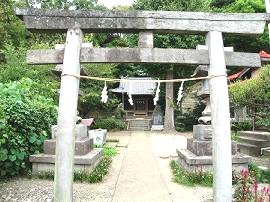
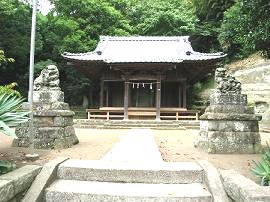
Location: The approach to the shrine starts in front of the east gate of Fukasawa Elementary School.
History: Shrine also called Goreisha, is, as the name implies, generally dedicated to the souls of local ancestors.
The shrine here is dedicated to Kamakura Gongoro Kagemasa (鎌倉権五郎景正, ?-?), the ancestor of both the Kajiwara (梶原) here in Kamakura and the Oba (大庭) in Fujisawa. The Main Hall houses a sitting wooden image of Kagemasa along with a similar statue of Kagetoki.
Kagemune (景宗), the son of Kagetada (景忠) and grandson of Kagemasa, formed the Oba clan, and Kagenaga (景長), another son of Kagetada, established the Kajiwara. After the Kajiwara family was destroyed, local people preserved the shrine and in time made it the tutelary shrine of Kajiwara village.
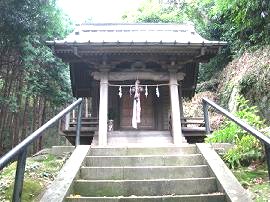
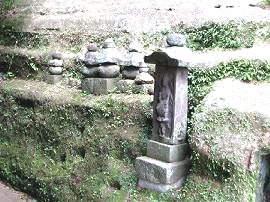
Grounds: Halfway along is a concrete torii in shimmei-style (神明), erected in 1984. Another torii in the same style but made in 1990 stands some 10 meters ahead.
Beyond the gate you will see a pair of stone lanterns and a pair of komainu (狛犬), literally, “Korean dog," a contribution to mark Japan's victory in the Russo-Japanese War. Behind Haiden Hall (Worship Hall), a flight of steep stone steps leads up to another courtyard, where the Main Hall is located.
In the cliffside east of the Main Hall are stone monuments of varying types, including gorinto and koshinto (庚申塔). Among the five gorinto-type stupas is one bearing the inscription 建武元年 (corresponding to 1334).
The annual festival is held on September 17.
It is said that Goryo Jinja Shrine in Sakanoshita (坂ノ下) was branched off from the shrine here.
| Nakito Stupa, literally, "Weeping Stupa" (泣塔) |
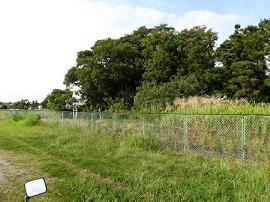
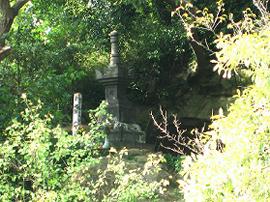
Location: The stupa stands inside the grounds of East Japan Railways Ofuna Factory, which is some 100 meters from Shonan Fukasawa Station on the Shonan Monorail Line.
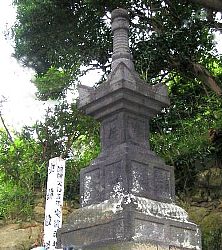
Grounds: To see the stupa, permission must be obtained from the Kamakura Board of Education. Some 200 meters beyond the factory office, you will see a tree-encircled mound on the right.
Atop the mound stands the Nakito Stupa, and in the recess behind it are several other gorinto-type stupas erected in memory of those who died in the battle of Susaki (洲崎) fought between the Kamakura and Nitta (新田) forces.
A story connected with the "Weeping Stupa" says that anyone who owned land here became poor without exception; thus, the land repeatedly changed hands. One of the landowners, who attributed this misfortune to the stupa, had it moved to Shorenji Temple (青蓮寺).
Soon after, neighboring people heard a sorrowful sound every night, as if someone was sobbing, and suspected it came from the stupa, which they assumed missed the place where it had once stood. After it was relocated to its former site, the sound was never again heard.
Another story says that the name of this stupa derives from the fact that the nearby recess gave off a weeping-like sound when the wind blew against it.
These stories are only part of the reason for the fame of this stupa, for the inscription it bears (文和五年, corresponding to 1356) gives it a cultural value that goes beyond its well-formed and balanced appearance. Small wonder, then, that it is designated a Cultural Property by the city.
| Susaki Battle Site Monument (洲崎古戦場碑) |
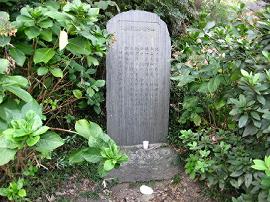
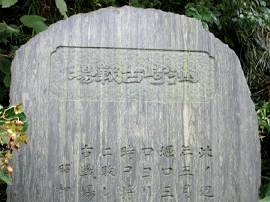
Location: A monument commemorating the battle of Susaki can be found by walking approximately 100 meters towards Ofuna from the Ofuna Factory of East Japan Railways, then an additional 50 meters off the main road and on the left.
Story: The monument itself is small and nondescript, belying the fact that a fierce battle was fought in this area between the Hojo (北条) and Nitta armies when, in the waning days of the Kamakura government, Nitta Yoshisada attacked Kamakura in 1333.
The neighboring area was called Susaki-go (洲崎郷), which includes present-day Yamazaki (山崎), Kamimachiya (上町屋), and Terabun.
At the head of his troops, Yoshisada (新田義貞, 1301-38) advanced close to Kamakura and the Hojo army went out to engage them. The battle ended in defeat for the Hojo. Forced to retreat, they decided to defend themselves around Susaki and rallied under Akahashi Moritoki (赤橋守時, 1295-1333), the last regent and general of the Hojo army. Sixty-thousand soldiers confronted the Nitta.
According to the Taiheiki (太平記) and the Baishoron (梅松論), written in the Muromachi period, battles were fought sixty times in one day and the Hojo's 60,000 warriors were reduced to a mere three hundred.
Humiliated by the defeat, Moritoki used his sword to commit suicide at Chiyozuka (千代塚) in Susaki. Just before his death, he reportedly said, “I am a relative of Takauji, who now supports Emperor Go-Daigo (後醍醐天皇, 1288-1339). Were I to surrender here, I would be suspected of having had secret communication with the enemy." The reasoning behind this statement is that Moritoki's sister had married Ashikaga Takauji (足利尊氏, 1305-58), which made them brothers-in-law.
Upon Moritoki's death, what was left of the Hojo army was thrown into confusion and retreated to Kuzuharagaoka Hill (葛原岡). The Nitta army then rushed into Kamakura via Kajiwarayama (梶原山) and Kuzuharagaoka.
The Hojo family members killed themselves at Toshoji Temple (東勝寺), and thus brought about the end of the Kamakura bakufu (鎌倉幕府). A number of stupas built in memory of those killed in the battle are even now found in the neighboring areas of Yamazaki, Kamimachiya, and Terabun.
| Taikeiji Temple (大慶寺) |
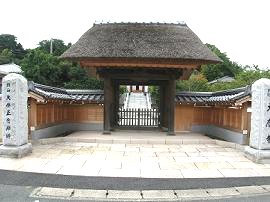
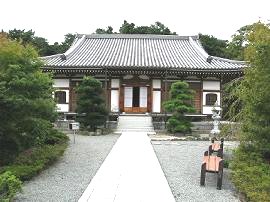
Full name: Reishozan (霊照山) Taikeiji
Denomination: Rinzai Zen sect (臨済宗)
Location: The temple is some 100 meters down the main road from the East Japan Railways Ofuna Factory on the opposite side and is sequestered among a number of houses.
History: The temple was built between 1278 and 1287 by Daikyu Shonen (大休正念, 1215-89), a.k.a. Butsugen Zenji (仏源禅師), who also founded Jochiji Temple (浄智寺) in Kita-Kamakura.
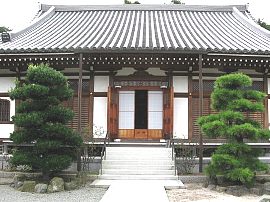
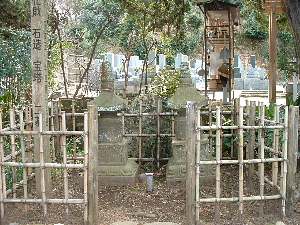
Grounds: In the Main Hall is a statue of Shaka Nyorai (釈迦如来), along with a statue of Daikyu Shonen. Within the grounds are two 700-year-old juniper trees, and under them are two one-meter-high hoto-type (宝塔) stupas.
| Tokoji Temple (東光寺) |
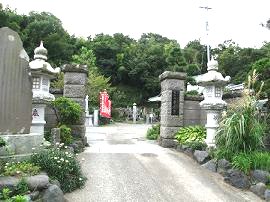
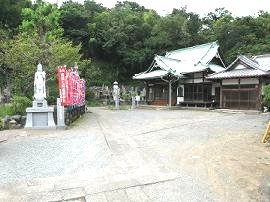
Full name: Tenshozan (天照山) Tokoji
Denomination: Shingon sect (真言宗)
Location: The temple is some 100 meters south from Taikeiji Temple. (above)
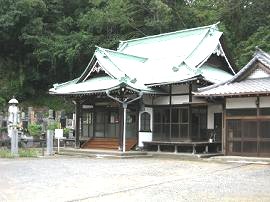
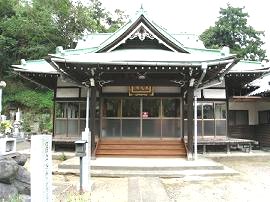
Grounds: Beyond the gate and in the center of the grounds, you will see a hall called Taishido (大師堂), which contains a statue of Kobo Daishi. To the right is the Main Hall, which houses an image of Fudo Myoo, said to have been made in the Heian period by Chisho (智証), also popularly called Enchin (円珍, 814-891).
| Fujiduka Mound (富士塚) |
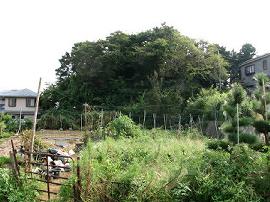
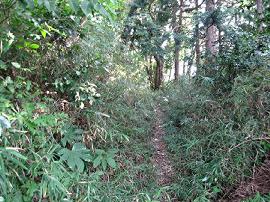
Location: To visit the Mound, cross the main road from Shonan Machiya Station on the Shonan Monorail Line, and walk along a meandering lane some 300 meters toward a hill until you reach some traffic lights. Turn to the right there, immediately turn to the right again, then continue some 200 meters and you will see Fuji Koen Park (富士公園) on the right. Walk straight, turn left at the end of the lane, then turn to the right at the T-junction, and a small hill will come into view.
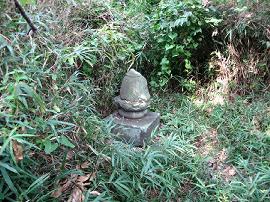 Grounds:
The top of Fujiduka Mound is supposed to have been shaped in the likeness of Mt. Fuji by the local people. Atop the mound are some stone monuments dedicated to the god of Sengen Jinja Shrine (浅間神社) in Shizuoka. Near the top of the mound is a statue of Shakyamuni made in 1849.
Grounds:
The top of Fujiduka Mound is supposed to have been shaped in the likeness of Mt. Fuji by the local people. Atop the mound are some stone monuments dedicated to the god of Sengen Jinja Shrine (浅間神社) in Shizuoka. Near the top of the mound is a statue of Shakyamuni made in 1849.One of its foundation stones is inscribed with the names of those who dedicated themselves to building the mound and belonged to Fujiko (富士講), a religious group for Mt. Fuji.
Such adoration of Mt. Fuji is said to date back to the very beginning of Japanese history when the mountain was first regarded as being sacred. Groups of Mt. Fuji worshippers came into existence in the sixteenth century and became very popular in the Edo period.
Many groups of Mt. Fuji pilgrims were formed, and miniature Mt. Fujis were erected everywhere so that those who could not climb the mountain itself could at least have the opportunity to worship it.
Utsumi Den'uemon (内海伝右衛門), a sendatsu (先達), or Fujiko Guide, is said to have climbed Mt. Fuji an astonishing 33 times, no small feat when we remember that access in that period was not as easy as now.